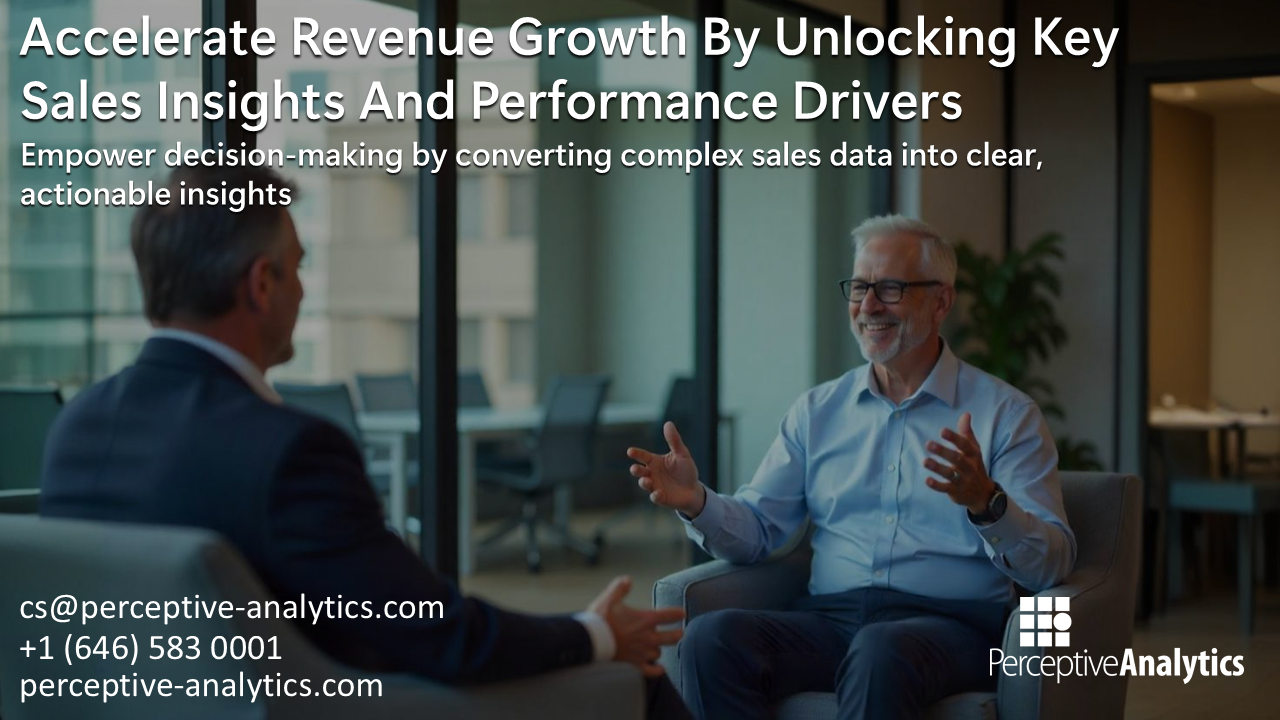

Driving Predictable Growth with Sales Analysis Dashboards: A Case Study in AI Finance Solutions
Executive Summary
- Client: Mid-sized AI finance solutions provider ($50M annual revenue, ~200 employees)
- Challenge: Fragmented reporting led to missed sales targets and unreliable forecasting; sales leaders lacked visibility into bookings, renewals, and opportunity stages.
- Tools: Tableau, Salesforce CRM, Excel
- Solution: Designed and deployed a centralized Sales Analysis Dashboard in Tableau, integrating bookings, renewals, total revenue, and pipeline stage analysis.
- Impact: Improved forecasting accuracy by 20%, increased renewal visibility leading to 8% uplift in retention, prioritized $13.68M pipeline opportunities, and reduced manual reporting time by 60%.
Introduction and Business Context
For an AI finance solutions provider operating in a highly competitive market, achieving consistent revenue growth depends on two capabilities: hitting new sales targets and retaining existing customers through renewals. Despite strong sales talent and a large pipeline, the company often missed growth opportunities due to late visibility into gaps.
Prior to this engagement, sales leaders relied heavily on monthly Excel extracts from Salesforce and ad-hoc PowerPoint summaries prepared by analysts. This process was slow, error-prone, and retrospective in nature. A recurring issue was that quarterly revenue misses were often explained after the fact, rather than anticipated in advance.
One example stood out: a quarter where the business forecasted meeting its $12M target, only to discover at the end that renewals worth nearly $3M had silently slipped. These blind spots forced leadership into reactive firefighting and eroded confidence in sales reporting.
The organization recognized the need for a real-time, unified sales analysis system. The vision was not just another reporting tool, but a decision-making platform that could guide leadership discussions, highlight risks early, and ensure accountability across teams.
Business Objectives
The engagement focused on four key objectives:
- Assess performance against sales targets
Enable leaders to track bookings, renewals, and total revenue in real-time against monthly and quarterly goals. - Improve forecast accuracy
Shift from “gut-based” projections to data-backed revenue forecasts that reflect pipeline maturity and renewal status. - Prioritize high-value opportunities
Surface the most valuable deals and flag stalled opportunities before they threaten targets. - Enable transparent sales reviews
Replace fragmented Excel files with a centralized dashboard used consistently in leadership meetings.

Outcomes and Measurable Impact
The deployment of the Sales Analysis Dashboard delivered measurable improvements in forecasting, sales execution, and operational efficiency.
1. Forecasting Accuracy Improved by 20%
Previously, revenue forecasts frequently deviated by 15–25% from actuals. With the dashboard, forecast variance dropped significantly as leaders could see both the total pipeline value and its stage distribution.
For instance, September’s forecast showed a $13.68M pipeline, but the dashboard revealed that nearly 70% of this value was stuck in early stages like “Initial Meeting” or “Define Prospect Needs.” By flagging this imbalance, executives adjusted targets and allocated resources to late-stage deals.


2. Renewals Became a Strategic Lever
Renewals were previously treated as routine, with the assumption that they would close automatically. The dashboard highlighted their importance by showing renewals vs. targets side-by-side with new bookings.
In one quarter, renewals accounted for more than a quarter of revenue, a fact that was underappreciated in older reports. Leadership responded by instituting proactive renewal campaigns, leading to an 8% uplift in retention rates within two quarters.

3. Sales Planning Time Reduced by 60%
Sales managers reported spending 6–8 hours per week compiling reports for reviews. After implementation, the same preparation could be completed in under 2 hours, as the dashboard auto-updated and presented data in a review-ready format.
This efficiency freed managers to spend more time on strategic account planning and deal coaching rather than data wrangling.
4. Focus on High-Value Deals
The dashboard surfaced opportunities worth more than $500K and flagged stalled ones. This ensured that leadership discussions centered on the deals with the most impact on revenue.
For example, a stalled $1.2M deal in the “Proposal Sent” stage was escalated during a review meeting, leading to executive-level intervention and successful closure.
5. Integration with CRM Accelerated Action
By linking directly to Salesforce, the dashboard allowed managers to drill down from aggregated insights to account-level detail. This reduced the cycle time between identifying an issue and taking corrective action by nearly 40%.

Our Approach
Discovery and KPI Definition
Workshops with sales, finance, and operations leaders clarified the KPIs that mattered most:
- Bookings vs. target
- Renewals vs. target
- Total revenue tracking
- Pipeline value
- Opportunity stage analysis
We emphasized aligning KPIs with business decisions. For example, instead of tracking raw opportunity counts, we prioritized value-weighted pipeline coverage ratios (pipeline value ÷ target) to reflect closing potential.

Dashboard Design and Development
The dashboard was built in Tableau with design choices tailored for executive adoption:
- Target vs. Actuals Comparison
Simple bar and line visuals enabled leaders to instantly assess whether the team was on track. - Stage Funnel Visualization
The pipeline was broken down by maturity stage, clarifying where deals were concentrated. - Color Coding
Blue for bookings, green for renewals, and grey for total pipeline ensured consistent recognition. - Drill-Down Capability
Executives could move from a quarterly summary to individual opportunity details in seconds.

Data Integration and Testing
Data integration pulled from three main sources:
- Salesforce CRM for opportunity-level detail
- Excel targets maintained by finance
- Revenue booking system for closed deals
Data was cleaned, standardized, and reconciled across systems to ensure a single source of truth. Iterative testing cycles ensured accuracy and usability.
Stakeholder Review and Adoption
The dashboard underwent two review cycles with sales leadership. Early feedback emphasized simplicity: executives wanted action-oriented visuals, not clutter. By the final iteration, adoption was seamless—executives began using the dashboard as the primary agenda for weekly reviews.
Key Learnings and Recommendations
- Granularity Prevents False Optimism
Headline pipeline numbers can be misleading without stage distribution. A $13.68M pipeline meant little when most deals were early-stage. - Renewals Deserve Equal Attention
The dashboard proved that renewals are just as critical as new bookings. CXOs should institutionalize renewal tracking as a core KPI. - Tableau as a Bridge, Not Just a Tool
By integrating Tableau directly with Salesforce, the dashboard moved beyond reporting into execution enablement. - Visualization Choices Matter
Using familiar visuals (bar, line, funnel) lowered the learning curve and encouraged daily adoption by senior leadership. - Efficiency is a Competitive Advantage
Cutting report prep time by 60% not only improved productivity but also shifted leadership focus from “what happened” to “what should we do next.”
Each month, we curate the latest updates, insights, and trends for senior leaders in data analytics and AI in our CXO Analytics Newsletter.
Our mission is “to enable businesses to unlock value in data.” For over 20 years, we’ve partnered with more than 100 clients—from Fortune 500 companies to mid-sized firms—to solve complex data analytics challenges. Our services include Advanced Analytics Consulting, Generative AI Consulting, and Business Intelligence (Tableau Consultants, Power BI Consultants and Looker Consultants) turning data into strategic insight. We would love to talk to you. Do reach out to us for a free consultation.
Our Work
Industry
- Industry
Function
- Function
-
Increasing Conversions with Adwords Spend Optimizer
How To Optimize Adwords Budget in Real Time
Free Download -
Markdown Optimization for Retailers
A Methodology to Track Performance and Maximize Value
Free Download -
Optimizing Marketing Spend with Marketing Mix Modeling
Using Statistical Modeling and Empirical Methods
Free Download -
Leveraging Web Analytics for Customer Acquisition
Leveraging Web Analytics for Customer Acquisition
Free Download
*Subscribe to be the first one to know our latest updates
Contact us





